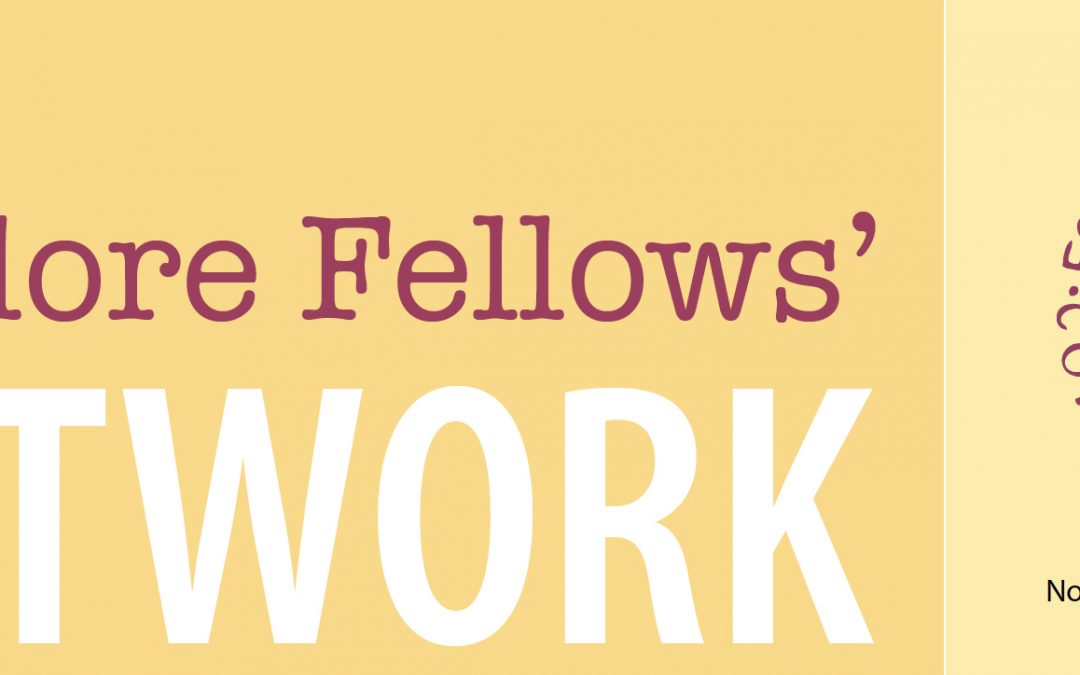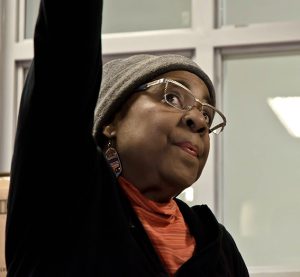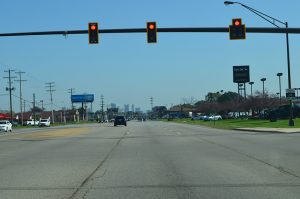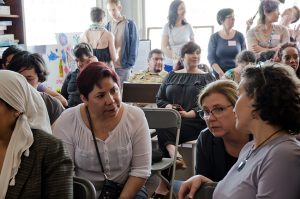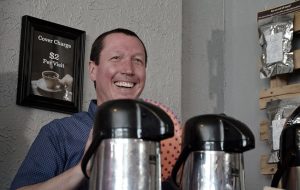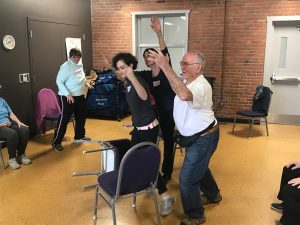Katherine Borland
Recently, I have been exploring the significance of contradictory statements in oral personal narratives and what they might tell us about social identities on the one hand and about the limitations of our research methods on the other. Although much of the early literature on life review focuses on the importance of achieving a coherent sense of self through narrative (Meyerhoff 1978, Linde 1993), speakers do contradict themselves in the course of being interviewed, and these moments often signal a discrepancy between their beliefs about themselves and the world and their actual experiences in the world.1The material for this essay is derived from my presentation at the Oral History Seminar at the Finnish Literature Society on May 6, 2019.
My material comes from a larger collaborative project called Be the Street, involving faculty and students from the departments of Theatre, Dance, Spanish and Portuguese, Comparative Studies and Folklore at The Ohio State University. The immediate goal of Be the Street is to create ensembles of performers in the Hilltop neighborhood of Columbus to devise theatre around the themes of migration, mobility, immobility and placemaking. Devising is a collaborative approach to performance that allows ordinary people to create work out of their shared group process (Heddon and Milling 2005). In Be the Street, pairs of graduate students, under the supervision of faculty mentors, conduct twelve to fourteen weekly devising workshops with their community ensembles. The ensembles subsequently perform together in a final public sharing of the work. Unlike other kinds of applied theatre projects at the university, the resulting performances are by, about, and for community members, and they take place in the Hilltop community.2For more on Be the Street, please visit our website at https://u.osu.edu/bethestreet/.
Performance-based Engagement with the Hilltop
Directly west of downtown Columbus, the Hilltop is a diverse neighborhood of 66,000 residents with significant refugee (most recently, Somali) and immigrant (mostly Mexican) populations. It has also long been a destination for mostly white, rural Appalachian migrants, who were initially attracted by once-plentiful jobs in the manufacturing sector. The neighborhood is 71 percent white, 19 percent Black and about 10 percent Latino. Bordered by interstate highways and bisected by Broad Street (the old Highway 40), it lacks a visible center. With a poverty rate of 22 percent, the Hilltop is not the poorest part of the city. However, after factories were shuttered in the 1980s, this once stable working-and-middle class neighborhood experienced a long slide into blight, with deteriorating housing stock, rising crime and the highest infant mortality rates in the city.
Over the past two years, OSU students and faculty have conducted over one hundred community devising workshops. In 2018, five different Hilltop ensembles came together for our public sharing. In 2019, three ensembles continued their collaborative work, and, in spring 2020, we will begin our third iteration of the Be the Street creative process. In addition to making a space for theatrical devising, reflection and cross-group dialog, Be the Street offers participants the opportunity to represent their communities in ways that counter and complicate the largely negative portraits of the Hilltop that populate the local news.
Engaged projects, such as this one, often involve considerable preliminary legwork. The interviews I will discuss here were conducted at the beginning of the project as part of our university team’s initial forays into the neighborhood. We invited several community leaders to share their life histories in audio- or video-taped sessions of about one hour. For the purposes of Be the Street, these life review interviews functioned as a way for the research team to get to know community actors and elicit their support and assistance in identifying people who might be interested in joining the theatre ensembles. The material did not directly inform the subsequent creative work, as it does in other kinds of oral history performance projects (Pollack 2005, Carver and Lawless 2010, Wong 2013), because the ensembles were generating their own material from the ideas and experiences of participants. As our Be the Street leadership team contemplates how these initial interviews might also be used for research into the dynamics of mobility, migration, immobility, and placemaking in the Hilltop, we recognize that they offer an invitation for further conversation rather than constituting finished narratives of belonging that we can confidently compare and analyze. Because we used an open-ended interview style, the community leaders were tasked with rhetorically constructing a coherent self that belonged to the Hilltop. Because in most cases we conducted only one interview, we were not able to clarify, challenge, or extend the narratives from an individualized to a group-based perspective. Indeed, our format encouraged the speakers to accentuate their own agency and distinctiveness as opposed to their participation in a collective, community building process. In other words, even though we were interviewing community activists, the focus on life review elicited tales of personal exceptionality rather than a broader social analysis. In reviewing the content of the interviews, we found that three of the activists shared a number of traits despite their diverse subject positions, providing some limited grounds for comparison.
Activists’ Common Life Experiences
White Appalachian John Rush arrived in the Hilltop with his family in 2012 at the invitation of a group of local business and community leaders. The owner and CEO of a transitional employment company, John provides jobs for people with histories of incarceration, sex trafficking, domestic abuse, and addiction. In 2018, John opened the Third Way Café as well. He hopes his coffee shop will be a place for neighbors to come together around neighborhood revitalization efforts and self-study. Ramona Reyes is the Chicana director of Our Lady of Guadalupe Center, a grassroots food pantry and resource center funded by Catholic Social Services that has served Spanish speaking residents since 2000. African-American Annette Jefferson is a retired community activist who once directed and still sits on the board of the Greater Hilltop Area Shalom Zone, a conscientiously interfaith and interracial organization that provides various kinds of direct services, such as summer camps for children. In addition, the Shalom Zone hosts a monthly luncheon where all the service organizations operating in The Hilltop get together to share information.3Although all three interviewees were asked to tell the story of how they came to work in and for the Hilltop, the interviews vary, in part due to a difference in format and the interviewer’s personal style. I audio-taped Annette and John in English. My colleague, Elena Foulis, video-taped Ramona Reyes in Spanish (I have translated the excerpts I include in this essay). The interviews were conducted in spring 2016.
In addition to combating poverty in the Hilltop, these three community activists share the experience of having grown up poor. John grew up with his father in a trailer park in a tiny rural town in West Virginia. He recalls that although their kitchen table was a couple of cardboard boxes, he didn’t realize he was poor, because his father used to take him to volunteer at the local shelter. Ramona is one of nine children born to migrant farm workers from Texas. She remembers working as a field hand at age six, picking tomatoes with her family. Nevertheless, Ramona’s mother made sure all her children finished high school and moved out of migrant labor. Annette was born in the Hilltop and was on her way to success when she got pregnant and dropped out of college. Not too long afterward, she found herself divorced as a mother of three, so she moved into public housing on the South side of the city, where she lived for ten years.
Additionally, all three activists stressed the support they received from their parents, who modelled civic engagement. All three also excelled academically. As a young man John joined the Marines and then pursued a Bachelors degree. Intellectually curious, he subsequently earned six Masters degrees in several fields ranging from Theology to Business. Ramona arrived in Columbus in the mid-1980s on a Campbell Soup Migrant Worker Scholarship. She earned a business degree and is the first Latina member of the Columbus Board of Education. Taking advantage of the educational opportunities that public assistance provided, Annette returned to college, graduating with a degree in Education. While working as a school teacher, she completed a double masters in Black Studies and Community Development. Subsequently, she earned a PhD in Social Work Administration.
Positioning in the Life Review Interview
Moving from content to rhetorical analysis, we find that each speaker adopts an agentive stance with respect to their life course. Michael Bamberg (1997) points out that when people tell personal narratives, they position themselves in three important ways: the self who is narrating to a given audience, the self in relation to the other characters in their story, and finally, a more enduring self whose essence remains the same over time and across variable circumstances. This self can be depicted in various ways, but for Bamberg, the essential distinction is between an agentive self, who acts upon the world and a victimized self, who is acted upon by external forces. Our speakers all tell their life stories from the perspective of an older, wiser self, looking back upon a younger, less aware version of themselves. In other words, each narrator expresses considerable reflexivity about their life course. John, for instance, talks about his younger self as full of good intentions but woefully lacking in worldly experience. A quick anecdote paints a picture of his generous but somewhat misguided teenage self:
But I remember meeting this guy and, real quick, this is a story, and again I just, I’m giving you everything. This dude was on the street corner, me and a guy named Nate, and there was one other fella that was with us that day, I can’t remember who it was, but… And we stopped, and asked this guy, you know, he had one of those signs, you know, “will work for food” or something. I can’t remember exactly what it said.
But I’m like, “Dude just hop in, Dude. Let’s just go for a ride, and we’ll take you to get something to eat.” We got to know this guy a little bit.
I’m like, you know, “Why don’t you come to school with me tomorrow, and you can share in homeroom a little bit of your story, and like, I’m sure we can help you, like, I’m president of student council, like, I’m sure there is something we can do as a school for you and help you.”
He’s like, “Oh Dude that’d be so cool,” you know.
And, I’m, I mean this is in high school; I’m still so naïve to everything. Y’know. Come to find out that he’s a registered sex offender and not supposed to be around minors, like, I didn’t know. I got him in, I kinda got him in tr- I’m sure I got him in more trouble than I realized at the time.4In this and subsequent excerpts, I have removed filler sounds, like um, for readability.
This anecdote illustrates John’s greater adult understanding of the complexities involved in helping others. It also suggests that John enjoys a kind of invulnerability. After all, it is the sex offender rather than John who ends up worse off as a consequence of their interaction. In this and other stories of his life progress, John is moved by the suffering of marginalized people, but he does not suffer. He describes his ever-widening embrace of different kinds of people, from the impoverished white community of his youth, to his friendship with an African-American boy when he moves to a larger town, to exposure to people from diverse backgrounds while serving in the military, to embedded and engaged community work in Chicago with African-Americans, Latinos, and a Muslim faith leader. As John’s world expands and diversifies, he experiences very little friction or conflict. Although he has not lived in the Hilltop for very long, John states that he and his family easily integrated into the neighborhood, which reminds him of his childhood home in West Virginia. In fact, after only a few years, John began to run for office on the Republican ticket to represent and serve his adopted community. Although he has not yet won an election, his narrative of belonging remains coherent and free of conflict.
In contrast, Ramona’s movement out of her home community to pursue college in central Ohio in the mid-1980s was a marginalizing experience. She mentions that only after moving to Ohio did she realize she was a hyphenated American. In Texas, surrounded by other people just like herself, she didn’t recognize herself as ethnically marked. Initially, community service provided a means for her to consolidate herself in her new home. However, she distinguishes between a younger self, who was exposed to but not impassioned by radical change agents, such as César Chávez, and her current self, who, she implies, identifies more strongly with this activist heritage.5Chávez was one of the leaders of the United Farm Workers movement. She remarks, “It’s difficult to go back to those times (college years) and know that I made a lot of mistakes, but at the same time, I’m happy that I’ve advanced a bit now.” Indeed, after graduation, Ramona fell into a job at Nationwide Insurance, where she enjoyed 24 years in management. Only in the past few years has she returned to direct service with and for people she identifies as much like the family and neighbors of her impoverished youth. Throughout her narrative Ramona implies without stating that she has shifted her focus from her own escape from poverty to a concern for Latina/o progress as a whole. She ends her interview with this brief, unelaborated analysis of her community’s current position, “Latinos are where Blacks were 25 years ago. Blacks sometimes fought for things that ended up not being positive, for example, integration. With integration, they lost out economically.” On the surface, this series of comments appears to argue against integration, but reading it thus would not be fair to the speaker. Instead, statements such as these function as provocations for follow-up interviewing that can allow Ramona to expand on her vision of how Latinos might emulate earlier Black struggles for equality and how they might focus their struggle differently. Researchers should neither smooth over statements such as these nor seek to analyze them without further discussion.
Annette identifies her youthful ignorance as a kind of protection from racism and exclusion. Indeed, throughout her interview Annette repeats in various forms the phrase, “I thought that was just something everyone did” to signal her adult understanding that although her family was working class, Annette’s parents and grandparents found ways to provide her with many of the trappings of a mainstream middle-class American childhood, such as summer trips and a savings account. More importantly, she distinguishes between her own immunity from racism and the indignities earlier generations had suffered. The following anecdote about Annette’s experience of traveling with her family in the pre-civil rights era south is representative of this positioning:
There was a Baptist Convention in Montgomery, Alabama, and my mother was a delegate. And I remember that we got on a bus, and of course, my sister and I, being from the North, we always liked to ride up front on the bus. So my dad tells a story that we sat down up front! So when Mom and Dad came—so you know, we went first, and we sat down. That’s what we always did. We sat down up front. And mom always had us looking nice. And so when Mom and Dad came, they said, “Come on, you have to move.” And Dad says a white woman said, “Oh, they’re so cute. Let them sit here with me.” So they went to the back, and we stayed up front.
In this instance the rules that apply to Annette’s parents do not apply to young Annette. In the Hilltop as well, Annette distinguishes her own experience from that of her mother:
KB: Were there any integrated churches when you were growing up?
AJ: No. But Oakley Baptist Church did have a service with Burgess Avenue EUB Church once a year. And the Pastor was Pastor Lane.
And I went to school with his son, Roland Lane. We went all the way through elementary to high school together. And even today, Roland and I are still friends, you know. He still lives on the Hilltop6In the local idiom, people speak of living on the Hilltop, which means they live in the Hilltop neighborhood.. And actually, he’s friends with my son too, because my son had Roland in high school. Roland taught at West High School.
So. And that happened for a number of years, and finally that stopped.
And I asked my mother, “Why did the service stop?”
And she said, “No sense in being false.”
You’d see those people at the church service, and then afterwards, they might not speak. They might not know you.
In her substantial digression at the beginning of this story, Annette points out that she and her son have interracial friendships, whereas her mother gives up on the interracial church service, because the fellowship does not extend to her everyday life. In her life review interview, then, Annette describes a marked shift from one generation to the next from social segregation to inclusion.
As I have mentioned, our research team was not able to conduct follow up interviews with all of our initial community partners. However, I did conduct two additional interviews with Annette, the last about one year after our initial meeting. This interview, which took place after the violent Unite the Right rally in Charlottesville, Virginia, focused specifically on race relations in the Hilltop, and Annette quickly qualified the narrative of racial progress and individual exceptionalism she had previously authored. In her final interview she describes the gradual growth of the Hilltop Black community along certain blocks, and their steady march west toward the neighborhood’s stable, middle-class center adjacent to Westgate Park, but she emphasizes she had to constantly assert her own right to belong:
And you’d better be careful about going into other blocks where black people didn’t live. And my mother would say, “you couldn’t light over on Westgate Park,” and to have her grandchildren go to Westgate School! You know, that was something. (laughs) She thought that was good! (laughs) And in fact, when my children were there, I remember going to the school, and the principal thought, you know, there was bussing7Bussing was a federal program designed to integrate public schools after the Brown vs. Board of Education decision in 1954. Children from one neighborhood would be bussed to schools in a different neighborhood so that each school would exhibit roughly the same diversity, regardless of segregated residential patterns.. She thought my children were bussed in from outside the neighborhood, and she said as much to me, “Oh you live so and so—”
I said, ‘No, my children walk to school.”
So that let her know, no, we live right here.” (Laughs) Those kind of separations.
Here, Annette begins her narrative in her customary way as a tale of generational progress, but the principal’s error demonstrates that increasing diversity entailed conflict and challenge, rather than being the kind of seamless experience John had narrated. Moreover, the refusal of some white residents to accept their Black neighbors meant that Annette, like her parents, had to learn lessons in abjection:
And I was the first Black, the first and only West Cat8The West Cats is the name of West High School’s drill team, an expensive extracurricular., but that was nothing new, because on the Hilltop, you grew up being in the minority. You knew how to conduct yourself around white people, and certainly it was different from how you conduct yourself around your friends! It was.
Because we were raised with, “You cannot do what they do. You just can’t. Cause you are colored.”
We were colored back then. Negro. (laughs)
And that is not transmitted to our kids nowadays. I think it’s a detriment, because the racism still exists. It’s not as overt, but we can see “Make America Great Again” is just a euphemism for Make America White Again. So you wonder where are we gonna be? The gap between economic haves and have not is wider and between racial distinctions it’s wider. So where are we going? You just don’t know. You wonder. It doesn’t look promising.
As Annette moves in this interview into a less optimistic register, she opines that contemporary Black children would benefit from learning the lessons of segregation, lessons that in her earlier life review interview, she claims not to have needed. As with Ramona’s cryptic final comment, this statement offers a provocation that the Be the Street research team plans to take up in the next round of interviews with community leaders.
Some Tentative Conclusions
Although I cannot offer definite conclusions about how this diverse set of Hilltop activists understand, value, and promote diversity as part of their antipoverty work, I do note that the narratives of women of color contain conflicting and contradictory elements that are absent from John’s narrative of an ever-widening embrace of difference. Annette, particularly, fails to reconcile her vision of herself as unblemished by racism with her experiences of social exclusion. Might it be that for marginalized individuals the task of producing narrative coherence masks contradictory positions, attitudes and experiences to a greater extent than for those who enjoy a measure of social privilege? Might the narrative dissonance arise precisely because one’s sense of oneself is being challenged rather than accepted and reinforced by one’s society?
Ultimately, for the Be the Street research team, discovering the interracial dynamics of belonging to the Hilltop will require interviews that move beyond the life review format. Our plan is to return to the neighborhood in autumn 2019 to experiment with story circles, inviting residents, ensemble participants, and neighborhood activists, to reflect together and across lines of difference on what it means to belong to this place. Daniel Kerr (2016), the oral historian of homelessness, argues that oral history has deep roots in an activist tradition. Employing interview methods that build solidarity, is necessary, he argues, if our research is to effect social change. We at Be the Street plan to take the provocations that Ramona and Annette have offered as our starting point for the next phase of our work, one that we hope will move us further toward our goals of advancing social justice both through art-making and through research with, by and for the people in the Hilltop.
- Community organizer Annette Jefferson during a BetheStreet creative movement class at the Hilltop YMCA. Photo by Victor Espinosa. April 2018.
- The Hilltop looking down Broad Street toward the Center of Columbus. Cut off from the city by a series of intersecting highways, the neighborhood lacks a visible center. Photo by Katherine Borland. Summer 2017.
- Community leader Ramona Reyes converses with OSU theatre faculty, Ana Puga and Janet Parrott, during the inaugural community performance of BetheStreet in April 2018 at the Third Way Café. Photo by Victor Espinoas.
- Community leader Johh Rush makes coffee at the inaugural community performance of BetheStreet in April 2018 at the Third Way Café. Photo by Victor Espinosa.
- BetheStreet Creative Movement Workshop for YMCA Seniors, spring 2018. Photo by Josh Truett.
References
Bamberg, Michael. 1997. “Positioning between Structure and Performance”. Journal of Narrative and Life History 7: 335–342.
Carver, M. Heather and Elaine Lawless. 2010. Troubling Violence: A Performance Project. Jackson: University Press of Mississippi.
Heddon, Deirdre and Jane Milling. 2005. Devising Performance: A Critical History. New York: Palgrave
Kerr, Daniel R. 2016. “Alan Nevins is Not My Grandfather: The Roots of Radical Oral History Practice in the United States”. The Oral History Review 43(2): 367–391.
Linde, Charlotte. 1993. Life Stories: The Creation of Coherence. Oxford, England: Oxford University Press.
Meyerhoff, Barbara. 1978. Number Our Days. First Ed. New York: E.P. Dutton.
Pollock, Della, ed. 2005. Remembering: Oral History Performance. New York: Palgrave.
Wong, Alan. 2013. “Listen and Learn: Familiarity and Feeling in the Oral History Interview”. In Oral History Off the Record: Toward an Ethnography of Practice. pp. 97–112. Eds. Anna Sheftel and Stacey Zembrzycki. New York: Palgrave.
